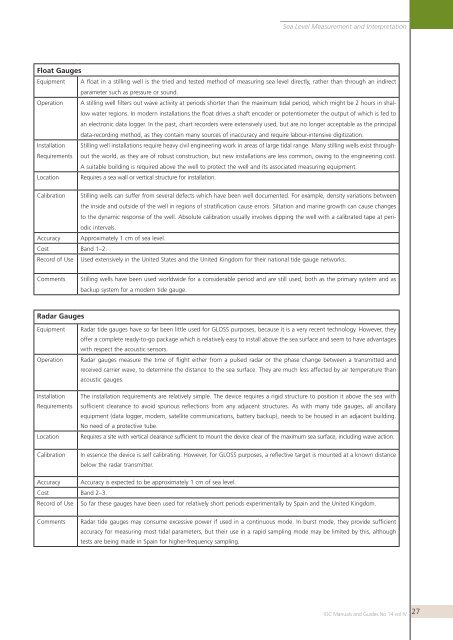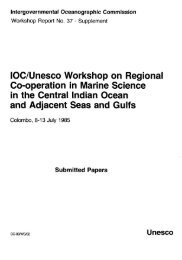Manual on sea level measurement and ... - unesdoc - Unesco
Manual on sea level measurement and ... - unesdoc - Unesco
Manual on sea level measurement and ... - unesdoc - Unesco
- No tags were found...
Create successful ePaper yourself
Turn your PDF publications into a flip-book with our unique Google optimized e-Paper software.
Sea Level Measurement <strong>and</strong> Interpretati<strong>on</strong>Float GaugesEquipment A float in a stilling well is the tried <strong>and</strong> tested method of measuring <strong>sea</strong> <strong>level</strong> directly, rather than through an indirectparameter such as pressure or sound.Operati<strong>on</strong> A stilling well filters out wave activity at periods shorter than the maximum tidal period, which might be 2 hours in shallowwater regi<strong>on</strong>s. In modern installati<strong>on</strong>s the float drives a shaft encoder or potentiometer the output of which is fed toan electr<strong>on</strong>ic data logger. In the past, chart recorders were extensively used, but are no l<strong>on</strong>ger acceptable as the principaldata-recording method, as they c<strong>on</strong>tain many sources of inaccuracy <strong>and</strong> require labour-intensive digitizati<strong>on</strong>.Installati<strong>on</strong> Stilling well installati<strong>on</strong>s require heavy civil engineering work in areas of large tidal range. Many stilling wells exist throughoutthe world, as they are of robust c<strong>on</strong>structi<strong>on</strong>, but new installati<strong>on</strong>s are less comm<strong>on</strong>, owing to the engineering cost.RequirementsA suitable building is required above the well to protect the well <strong>and</strong> its associated measuring equipment.Locati<strong>on</strong> Requires a <strong>sea</strong> wall or vertical structure for installati<strong>on</strong>.Calibrati<strong>on</strong> Stilling wells can suffer from several defects which have been well documented. For example, density variati<strong>on</strong>s betweenthe inside <strong>and</strong> outside of the well in regi<strong>on</strong>s of stratificati<strong>on</strong> cause errors. Siltati<strong>on</strong> <strong>and</strong> marine growth can cause changesto the dynamic resp<strong>on</strong>se of the well. Absolute calibrati<strong>on</strong> usually involves dipping the well with a calibrated tape at periodicintervals.Accuracy Approximately 1 cm of <strong>sea</strong> <strong>level</strong>.Cost B<strong>and</strong> 1–2.Record of Use Used extensively in the United States <strong>and</strong> the United Kingdom for their nati<strong>on</strong>al tide gauge networks.CommentsStilling wells have been used worldwide for a c<strong>on</strong>siderable period <strong>and</strong> are still used, both as the primary system <strong>and</strong> asbackup system for a modern tide gauge.Radar GaugesEquipmentOperati<strong>on</strong>Installati<strong>on</strong>RequirementsLocati<strong>on</strong>Radar tide gauges have so far been little used for GLOSS purposes, because it is a very recent technology. However, theyoffer a complete ready-to-go package which is relatively easy to install above the <strong>sea</strong> surface <strong>and</strong> seem to have advantageswith respect the acoustic sensors.Radar gauges measure the time of flight either from a pulsed radar or the phase change between a transmitted <strong>and</strong>received carrier wave, to determine the distance to the <strong>sea</strong> surface. They are much less affected by air temperature thanacoustic gauges.The installati<strong>on</strong> requirements are relatively simple. The device requires a rigid structure to positi<strong>on</strong> it above the <strong>sea</strong> withsufficient clearance to avoid spurious reflecti<strong>on</strong>s from any adjacent structures. As with many tide gauges, all ancillaryequipment (data logger, modem, satellite communicati<strong>on</strong>s, battery backup), needs to be housed in an adjacent building.No need of a protective tube.Requires a site with vertical clearance sufficient to mount the device clear of the maximum <strong>sea</strong> surface, including wave acti<strong>on</strong>.Calibrati<strong>on</strong>In essence the device is self calibrating. However, for GLOSS purposes, a reflective target is mounted at a known distancebelow the radar transmitter.Accuracy Accuracy is expected to be approximately 1 cm of <strong>sea</strong> <strong>level</strong>.Cost B<strong>and</strong> 2–3.Record of Use So far these gauges have been used for relatively short periods experimentally by Spain <strong>and</strong> the United Kingdom.CommentsRadar tide gauges may c<strong>on</strong>sume excessive power if used in a c<strong>on</strong>tinuous mode. In burst mode, they provide sufficientaccuracy for measuring most tidal parameters, but their use in a rapid sampling mode may be limited by this, althoughtests are being made in Spain for higher-frequency sampling.IOC <str<strong>on</strong>g>Manual</str<strong>on</strong>g>s <strong>and</strong> Guides No 14 vol IV27
















